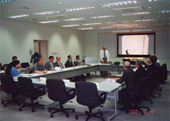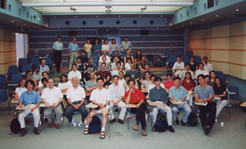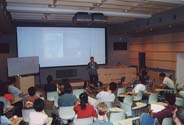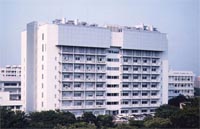  |
 |
 |
Neuronal
Function Research Group Performance Evaluation |
 |
 |
| A meeting of the Research Review Committee |
On June 12
and 13 of this year, the Research Review Committee met and carried out a five-year
performance evaluation of the Neuronal Function Research Group, which is headed
by Dr. Kensaku Mori. The Group, which consists of four laboratories, was originally
established as part of the RIKEN Frontier Research Program in 1995. The Review
Committee, which is comprised of experts from around the globe, is an integral
part of BSI that serves to evaluate each lab's progress, research results and
overall future potential using a strict set of criteria. The results of the review
(Review Report) provide the necessary background information from which the next
five year plan of each Group and its associate laboratories can be formulated.
The Review Committee for the Neuronal Function Research Group was composed of
12 Reviewers: eight from abroad and four from Japan with Prof. John Hildebrand
from the University of Arizona, USA serving as Chair. Prior to the meeting, a
preliminary Mailing Review was conducted so that each Reviewer could familiarize
themselves with the last four years of each laboratories research activities.
The Review Committee Meeting began with concise thirty minute presentations by
each of the Laboratory Heads in which past results and future possibilities were
discussed and clarified. Enthusiastic discussions between the Laboratory Heads
and the Reviewers followed. The following morning, the Reviewers spent time visiting
each laboratory for more in-depth discussions with the researchers. That afternoon,
a completed Review Report was submitted to the Director of BSI, Dr. Masao Ito.
A summary of the Review Report is as follows:
・ The Neuronal Function Research Group utilizes contemporary cellular and molecular
approaches to investigate the organization, function and development of mammalian
neural systems. By means of these powerful tools, the research is able to provide
significant insights that are critically important for the advancement of modern
brain science. Thus, the Group is a vital and integrated component of BSI that
fills an essential role and should continue the general thrust of its research
into future.
- Although the Review Committee strongly supports the organizational principals,
goals and future endeavors of the Group, a reorganization of the laboratory during
the next five-year research cycle is suggested.
- Given that the current Group Director, Dr. Mori, will transfer to the University
of Tokyo, a new Group Director should be recruited as soon as possible. The new
Group Director should have a superior grasp of coordinating and integrating various
molecular, cellular and system approaches in addition to having a distinguished
flair for combining scientific depth with a cross-disciplinary outlook.
- Consideration should be given to establishing a permanent position and encouraging
increased research collaboration.
|
 |
 |
BSI
Summer Program 2000 a Success |
 |
 |
| BSI Summer Program 2000 Participants |
Lecture courses for the second BSI Summer Program were held over the course of
two weeks, from July 4 to 15. Approximately 50 young researchers representing
13 countries and 19 nationalities, including Japan, attended along with a staff
of 25 lecturers from Japan and abroad, 11 of which were from BSI. This year, the
program was entitled, "How the Brain Works: Experimental and Theoretical
Approaches," and its principal purpose was to provide each of the attendees
with the fundamental concepts of brain functions, covering every aspect from synapses
to systems from an experimental and theoretical point of view. The remaining hours
of the program were used to provide attendees with ample time to visit laboratories,
present research results and give their own self-introductions. This was done
in an attempt to promote interaction among the attendees, lecturers, and BSI members.
In addition to the lecture courses, internship courses were also offered during
the program, in which certain researchers were able to participate in the activities
of various BSI laboratories for a period of about two months. The significant
result of this was that it allowed the attendees a unique opportunity to acquire
new techniques and develop their skills while also helping to pave the way for
future collaborations with BSI. This type of summer program can be commonly found
at anyone of the first-rate universities or research institutions in Europe and
the U.S. and is a way of educating and training young researchers in the latest
developments of the field. In Japan, however, such programs are still quite rare,
and as a result, there were a variety of challenges, especially with regards to
planning and management. Nevertheless, a unique and successful program that reflected
the best of BSI was put together. We hope to continue this program and continually
improve upon it in order to contribute towards the advancement of brain science
around the world. The Summer Program 2001 will be entitled, "Brain Dysfunction:
Molecular
 |
| A conference at the BSI Summer Program |
and Cellular Bases (working
title)," and is scheduled to be held for approximately two weeks beginning
June 26. For more information, please refer to the prospectus from this yearユs
summer program or visit BSIユs website which contains additional details about
the Summer Program 2001 (http://summer.brain.go.jp). We look forward to an exciting
2001 summer program and to receiving a great number of applications from many
young and eager researchers around the world.
|
 |
 |
BSI
Central Building Complete |
 |
 |
| BSI Central
Building |
The second phase of construction
on the BSI Central Building was completed this past July according to schedule.
Now, in addition to the first phase, which was completed last April, the fully
completed BSI Central Building stands nine stories above ground with one underground
level and contains approximately 27,000m2 of floor space. The newly constructed
area has slowly been coming to life with new equipment and new laboratories moving
in. In addition to laboratories, the newly completed area will support an Exhibition
Room (Brain Box) and a Refreshment Room, both of which are currently being completed.
With the completion of the Central Building, the BSI Complex now consists of three
buildings "the Central, East, and West Buildings" with approximately.
300 people from 37 different laboratories involved in various research.
|
 |
 |
A
New Group and New Laboratories Started |
 |
BSI started the
Laboratory for Molecular Dynamics of Mental Disorders in Aging in the Psychiatric
Research Group this September. In October, the Recovery Mechanisms Research Group
and the Laboratory for Cell Recovery Mechanisms were established. In addition,
this November saw the starting of the Laboratory for Perception Dynamics, which
is in the Brain-Style Information Systems Research Group. The Laboratory for Molecular
Dynamics of Mental Disorders (Head, Dr. Tadafumi Kato) will conduct research using
cultured cells and brains from autopsies that have undergone cultivation tests,
etc., with the aim of elucidating the causes of two major mental disorders manic
depressive psychosis (bipolar disorder) and schizophrenia, which are serious,
frequently occurring illnesses. The Recovery Mechanisms Research Group, in the
field of protection, will conduct research on the differentiation of neural stem
cells, which is the basic means for recovering neurons, along with research on
elucidating the mechanisms of neuron death. The Laboratory for Cell Recovery Mechanisms
(Head, Dr. Masayuki Miura), which was the first laboratory established in this
research group, will conduct research on the meaning of neural cell death, as
well as its molecular mechanisms. In addition, the laboratory plans to expand
its area of research in order help patients recover from functional disorders
related to the nervous system, and to also elucidate the causes of neurodegenerative
diseases by extrapolating upon the obtained research results. The Laboratory for
Perception Dynamics (Head, Dr. Cees van Leeuwen) will conduct research on the micro-dynamics
of visual perception and its associated memory functions (for example, iconic
and visual working memory), as well as on perceptual and classification learning. |
 |
 |
RIKEN-MIT
Neuroscience Research Center Steering Committee Meeting Held |
 |
The RIKEN-MIT Neuroscience
Research Center's first Steering Committee Meeting was held on September 7 at
BSI. In attendance were the three Committee Members; Dr. Robert J. Silbey, Dean
of Science at MIT; Prof. Susumu Tonegawa, Director of the Center; Dr. Masao Ito,
Director of BSI and Ms. Julie Norris, Director of the Office of Sponsored Programs
at MIT. There was discussion of the current situation regarding joint research
as well as talk about upcoming research plans. It was agreed at the meeting that
from this point forward even greater efforts to promote joint research should
made. |
|
|





